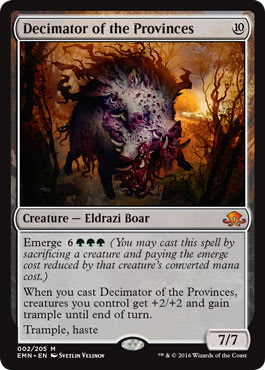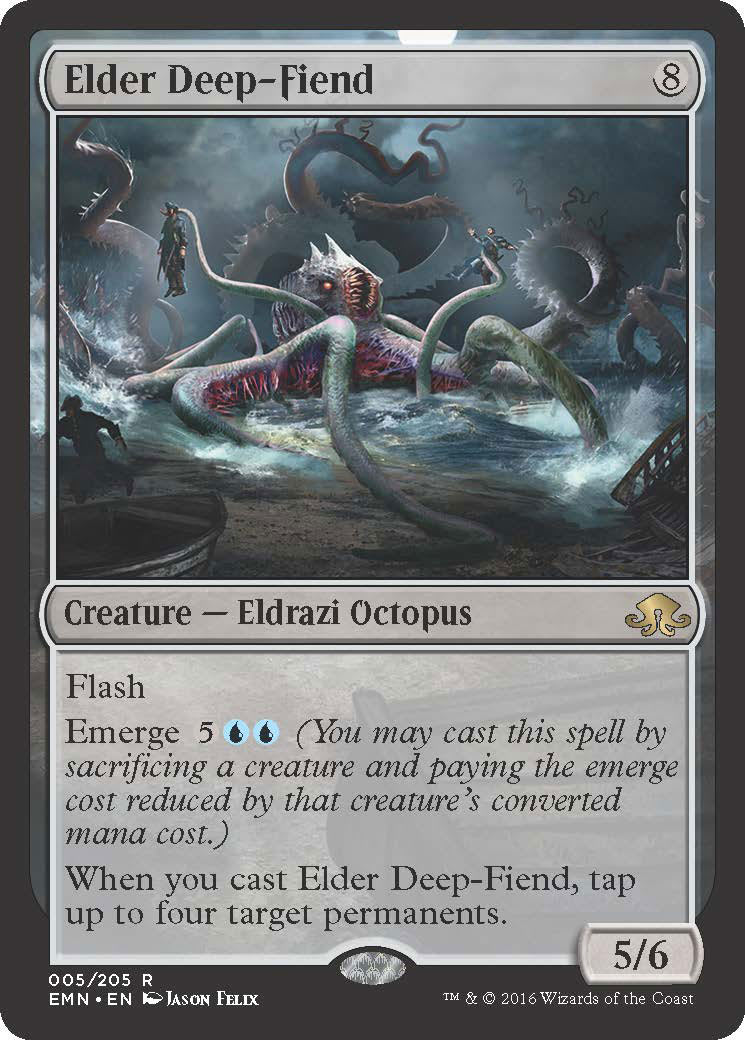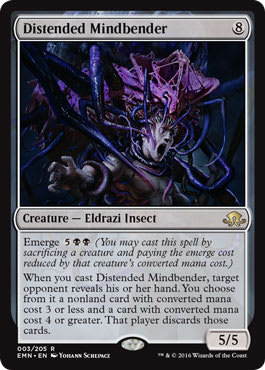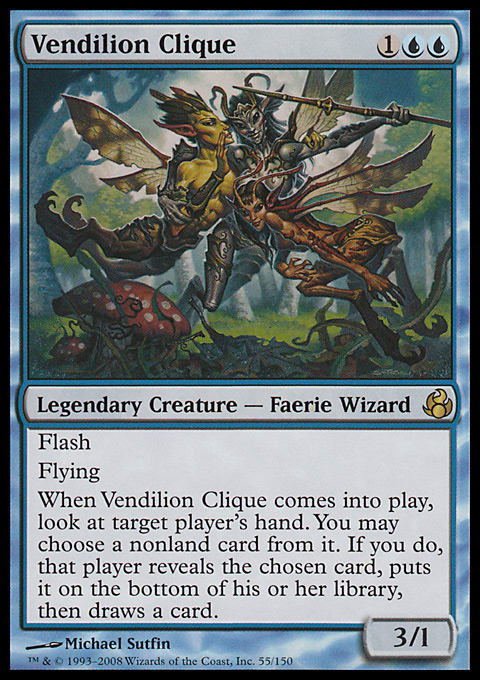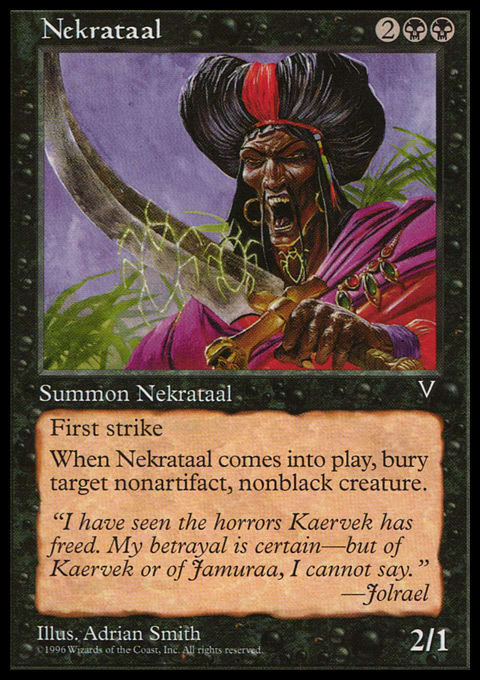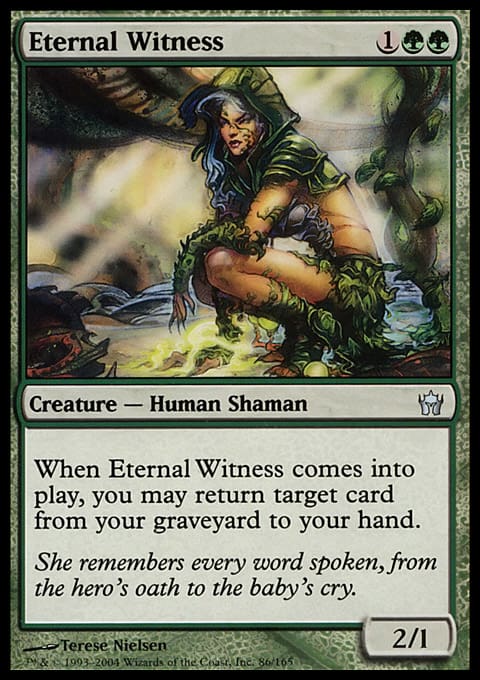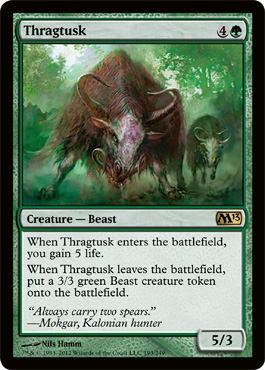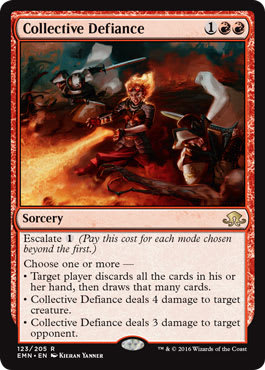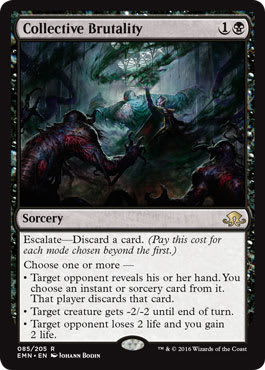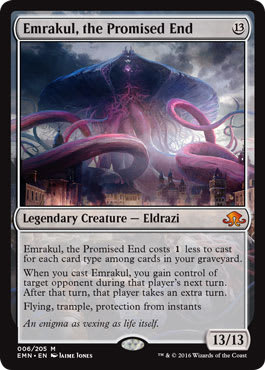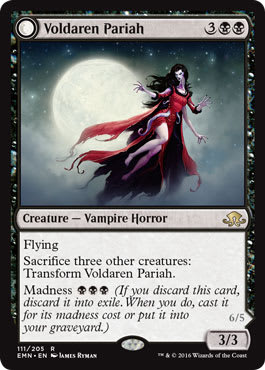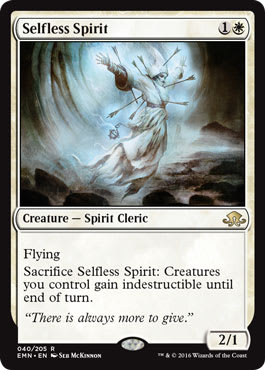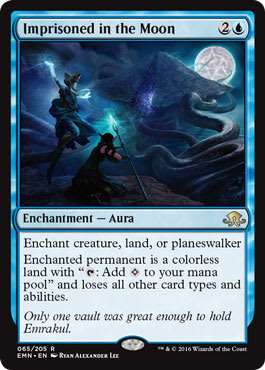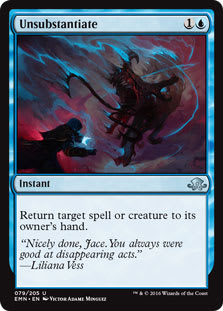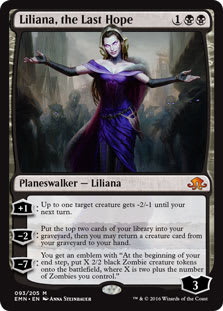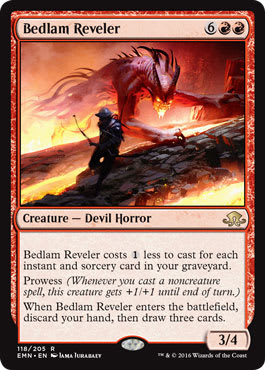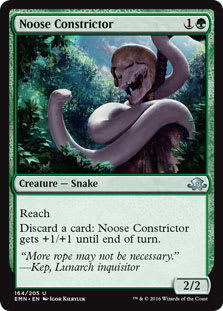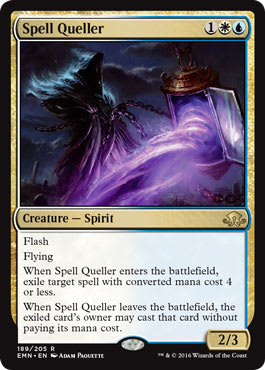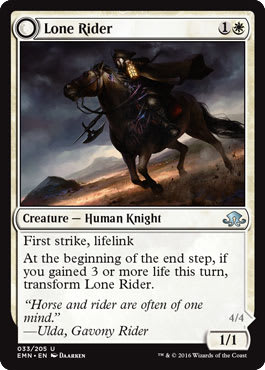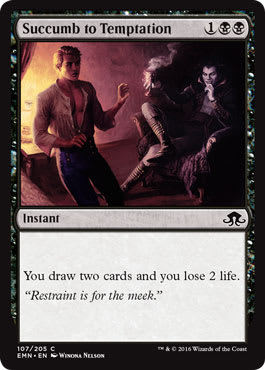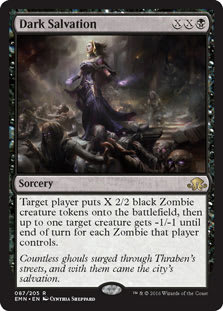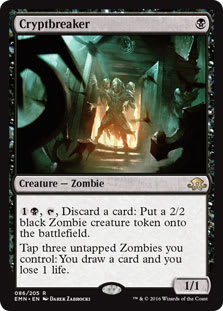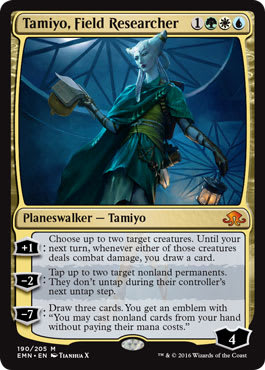In this article, I'll be talking about what Eldritch Moon brings to Cube. First, I'll discuss how the set's mechanics manifest in Cube.
Emerge and related cards.
Patrick Chapin wrote an article and talked in his book about defining creatures as "Baneslayers and Mulldrfiters" with Baneslayers being creatures whose value is entirely centered on the creature itself, and Mulldrifters, creatures who have value outside of the creature itself.
Birthing Pod was unique as it used the body of a Mulldrifter as a resource, since, once a Mulldrifter did its thing, there was an unused resource of having a ![]()
![]() body on the table for a 2/2 flier. This was normally worth about
body on the table for a 2/2 flier. This was normally worth about ![]()
![]() . It generally didn't matter that the resource was on the battlefield.
. It generally didn't matter that the resource was on the battlefield.
In Cube, since Cube decks are 40 cards, Birthing Pod has historically had a weakness where its chain can be difficult to construct. Unlike in Constructed, Birthing Pod chains don't tend to be robust since a Cube deck with Birthing Pod is generally a midrange deck that happens to have Birthing Pod, not a Birthing Pod deck. Because of this, if the creature was no longer in the library, it was harder to “chain upward”, as the chain may be broken. That said, when Birthing Pod fires on all cylinders in Cube, it works incredibly well in tandem with what midrange decks want to be doing – Junding Them Out with attrition and value.
Eldritch Moon's sacrifice-centric cards, Eldritch Evolution and the Emerge creatures, work similarly by utilizing leftover bodies from Mulldrifters to get additional value.
Of note, I'll be using the Cube Tutor card averages for what's used in an “average” Cube of that size, typically referencing the Cube Tutor average 450-card Cube as a commonly accepted average size. It's not perfect (the algorithm changed so Cubes that aren't updated in the past 6 months don't count and tends to trend toward not including newer cards, as Falkenrath Gorger isn't in the average) but it's a good analog of showing what contexts are to be expected in an “average” Cube of that size, rather than just referencing a specific list or two.
As Elder Deep-Fiend and Distended Mindbender have an emerge cost of 7 converted mana, let's look at how Dimir Mulldrifters are represented at 3-4 mana, as well as creatures that retain value even if they die:
Trinket Mage, Vendilion Clique, Pestermite, Deceiver Exarch, Man-o'-War, Phyrexian Metamorph, Venser, Shaper Savant, Glen Elendra Archmage.
Ophiomancer which only somewhat fits. Nekrataal and Skinrender.
Cards like Aether Adept, Geralf's Messenger, Flesh Carver and Whirler Rogue are all great cards that can supplement emerge cards that don't require sacrificing power as they all stand toe-to-toe with other cheap Dimir Mulldrifters.
Looking at the above suite, it's a bit thin to use either Elder Deep-Fiend or Distended Mindbender as intended, by using a 3-drop Mulldrifter and having one of the Eldrazi emerge from it.
Is the payoff worth it for these?
Brad Nelson wrote a recent article comparing Deep-Fiend to Mistblind Clique and Sam Stoddard's recent development article confirms that this was intentional.
While there are obvious differences, like Mistbind Clique forcing you to be in a tribe and therefore forcing you to bend your entire deck around it, Elder Deep-Fiend is just fine even outside of the best case 3-cost Mulldrifter case. Blue control decks may find that sacrificing a creature is a real cost if they have low creature counts, even if those few creatures are typically Mulldrifters since paying retail cost for these emerge cards is a poor rate, but in decks that have enough cannon fodder for Elder Deep-Fiend, it's a great addition.
Distended Mindbender
It's true that although control decks are historically defined by high-cost threats, they aren't the majority of their cards. This explains why Inquisition of Kozilek is still great against slower decks, as they're still running cards like Counterspell and cheap removal to supplement the threats at the higher end of the mana curve. My opinion cooled on Distended Mindbender as it was more reliant on hitting on curve than Elder Deep-Fiend and Decimator of the Provinces, as hitting only 1 card off of its trigger was a bad deal.
On the other hand, I've become more impressed with Decimator of the Provinces as I've been trying it out. Since its emerge cost costs 9 mana to emerge, we'll want to evaluate it in the context of that, with 4-5 cost Green Mulldrifters in mind. Going back to the CubeTutor average 450, we'll find the following from the middle of the mana curve:
Eternal Witness, Reclamation Sage and Yavimaya Elder.
Master of the Wild Hunt somewhat fits like Ophiomancer, but it isn't something we will want to sacrifice.
Acidic Slime and Thragtusk fit the bill very well. Deranged Hermit is a stretch since it requires echo to be paid for it to hang around for a turn cycle.
Like Craterhoof Behemoth, it isn't the best creature to renimate, moreso because its mini-Overrun is a cast trigger and can't even be fetched with Natural Order or Green Sun's Zenith. That said, it's pretty easy to underestimate just how huge a 7/7 hasty trampler is on a board state, as I've found it's generally easy to ramp into with few other creatures and then bash the opponent's head in with a 7/7 trampler.
Since it's in Sultai, it can take advantage of Mulldrifters in other colors as well.
One weakness is if it does get disrupted, either by being countered or killed, it doesn't leave a lasting impression like the other emerge creatures, but I find that it works well with the overall gameplan of Green ramp getting something big into play and ending the game.
Meld
Gisela, the Broken Blade is the best card with Meld, as her stats are very good on their own. 3 toughness means that she dies to bolts, but is this a critical weakness? Looking at the CubeTutor 450-average for things that deal damage out of its 59 Red cards:
2 damage: Pia and Kiran Nalaar, Magma Jet, Staggershock, Firebolt, Arc Trail, Grim Lavamancer, Pyroclasm, Siege-Gang Commander (8 cards)
3 damage: Inferno Titan, Chain Lightning, Lightning Bolt, Incinerate, Searing Blaze, Searing Spear, Lightning Strike, Brimstone Volley, Rift Bolt (9 cards)
4 damage: Flametongue Kavu, Sarkhan, the Dragonspeaker, Burst Lightning (kicked,) Char, Stoke the Flames, Fireblast, Mizzium Mortars, Wildfire (8 cards; not counting Burning of Xinye)
This does mean she does die to a lot of Red spot removal. That said, it does put a lot of pressure on opposing Red decks to have an answer for it or quickly lose, so she's still great against those decks.
Although something is to be said of White's 4 mana cards being extremely competitive. Gisela has the raw stats to compare with them. Although she has no immediate impact, she has a lot of raw power to be played in all types of White decks; at 4 mana, she's played roles from control threat to aggro curve topper.
Unfortunately, Gisela's flip side, Bruna, the Fading Light, just isn't very good for Cube as it compares very poorly to other White 7s like Elesh Norn, Grand Cenobite, Angel of Serenity, and Martial Coup, since her impact is low.
There's been a good amount of attention paid to Hanweir Garrison, as it's a card similar to Goblin Rabblemaster and Hero of Bladehold as a delayed army in a can that can snowball relatively quickly, even if it can get brick-walled by 3+ mana creatures like 3/3 beasts. Its token generation works with Purphoros, God of the Forge and Goblin Bombardment as well as with Red attacking decks' game plans of getting as much damage in as possible. Its 3 toughness is great in a format with many 2-power beaters and value threats too.
Even without factoring Oath of the Gatewatch's Eldrazi, which utilize colorless mana, Hanweir Battlements works well in Red decks as a way to provide to the later stages of the game for aggro threats. The only cube-worthy lands we've seen that give haste are Slayers' Stronghold, which typically competes with other multicolored lands and thus has higher competition, and Flamekin Village, whose entering the battlefield tapped was annoying for Red decks that wanted to curve out. I've found that the “mana tax” of ![]()
![]() isn't too bad, and, while It's costly in the early stages of the game, this card isn't meant for the early stages of the game anyway. Most Red 4s naturally have haste anyway, though, but the same can't be said for non-red 4-drops.
isn't too bad, and, while It's costly in the early stages of the game, this card isn't meant for the early stages of the game anyway. Most Red 4s naturally have haste anyway, though, but the same can't be said for non-red 4-drops.
Escalate
Flexible cards in Cube tend to have one mode which does what Cube decks want at a base rate, even if they're not the most effective. Cards such as Burst Lightning, Shriekmaw, Mulldrifter are classic examples. The Mardu Collective cards work in a similar fashion, by scaling up cheaply, but do so at the cost of making their base rates relatively expensive.
Looking at Collective Defiance, since the individual modes are all pretty over-costed; it's more about trying to find a base mode based on combined modes and seeing if it works out from there. The mode that I found was used most was casting it for ![]()
![]()
![]() , dealing 4 damage to a creature and 3 to a player. dismissing this as “just Chandra's Outrage” I wrong because it discounts flexibility, but I found that it wasn't really efficient; a metric which Red burn spells live and die by. Tolarian Winds is an incredibly useful ability to tack on and works well by helping to organically support graveyard, but overall, my Initial impressions cooled down after trying it out.
, dealing 4 damage to a creature and 3 to a player. dismissing this as “just Chandra's Outrage” I wrong because it discounts flexibility, but I found that it wasn't really efficient; a metric which Red burn spells live and die by. Tolarian Winds is an incredibly useful ability to tack on and works well by helping to organically support graveyard, but overall, my Initial impressions cooled down after trying it out.
The other 2 Collective cards are worse as they don't have a base rate which works well for Cube decks either.
Next, I'll discuss how Shadows over Innistrad's mechanics manifest in Cube.
Emrakul, the Promised End
While Emrakul doesn't have Delirium, her cost reduction is a riff on that mechanic by rewarding you for having different card types in the graveyard.
When she was first spoiled, she was pretty underrated as she operates on several axises which we haven't seen very often and, thus, tended to be evaluated incorrectly.
We've been taught as players to not go to Magical Christmasland and not to evaluate with best-case scenarios in mind, but I've found that can lead to going to the other end of the pendulum and always assuming the worst-case. These assumptions don't take into account how these kinds of cards tend to actually play out.
I've found that Emrakul doesn't cost anywhere near 13 mana; as she typically costs between 8-11 mana in control decks, less mana in control decks since they're naturally filling the graveyard and more in ramp decks, as card types naturally tend to go into the graveyard over the course of the long game. These are in decks that aren't building with Emrakul specifically in mind and the mana cost isn't an unreachable goal for either theater of deck, and, unlike other delirium cards, her impact is immedate and powerful.
While Emrakul's Mindslaver ability is ostensibly worse than the original card, I've found that her being a giant creature helps to mitigate the worst-case of Mindslaver being a Silence, as she typically causes their best creature to charge headlong into death. Even if the opponent gets a turn to recover, I've found that it isn't enough time to truly recover from the damage that Emrakul did. All in all, she's been a wonderful tool for ramp and control decks in Cube.
Stromkirk Occultist and Voldaren Pariah
Like other Madness cards, these are mediocre without being cast for Madness. In Cube, there aren't full-on Madness decks and acts as more of a subtheme in decks.
Stromkirk Occultist compares to Prophetic Flamespeaker with having trample and the ability to Elkin Bottle draw, but 2 toughness means that it generally trades with most things that could block it. Since it has trample, that does mean that it Elkin Bottles once, but, as it's a poor method of evasion, it's yet another saboteur without evasion.
Voldaren Pariah's body is unfortunately a bit too small for consideration in Cube, since its flip trigger is very demanding.
Lastly, we'll discuss the other cards in the set.
White
Thalia, Heretic Cathar — while 3 drops have generally lagged behind 2 and 4 drops in most colors in Cube, White's gotten a lot of great ones. Cards like Paladin En-Vec become relics from yesteryear as cards like Brimaz, King of Oreskos and Hallowed Spiritkeeper have been released.
The problem with Imposing Sovereign was her body tended to be lacking since, once the creatures got untapped, just about everything trades with her. Thankfully, 3 power of first strike slices through most of the threats that get deployed in the early game, does a surprisingly decent impression of Moat and stops bigger things from blocking Thalia with a strong on-curve body. Although the non-basic land text is the lesser of the abilities, it does make things like curving out more awkward for the opponent if they're playing a lot of non-basics, making her a first-class aggro threat and something to highly consider for your Cube.
Selfless Spirit — Similarly, Stormfront Pegasus isn't seen in many Cubes nowadays as it's not even in the CubeTutor 720 average Cube, thanks to the improved quality of ![]()
![]() creatures like Seeker of the Way and Soulfire Grand Master.
creatures like Seeker of the Way and Soulfire Grand Master.
Its ability to sacrifice itself and protect your team works to protect against mass-removal, creatures, and messy combat. It's a bit fragile, as the opponent may be able to just kill it at end of turn and then wrath on their main phase; but, in instances where that isn't occurring, the Threat of Activation can make using mass removal a poor tempo play. It is vulnerable to spot removal, though, so overextending into a wrath is still wrong.
Like Thalia, it works on similar axis with what aggressive decks want to do and even has potential in midrange White decks as well. While not on the level of premiere White 2s like Stoneforge Mystic, it's a great tool for White aggressive decks to fight one of their historical weaknesses.
Blue
Imprisoned in the Moon —Song of the Dryads often tends to target creatures and Planeswalkers, and I've found Imprisoned in the Moon tends to hit these same targets since most artifacts that would be good to turn off often tend to be creatures. It performs similarly as both Blue and Green are colors that tend to not have direct answers to these kinds of cards, especially creatures. So, if you've enjoyed Song of the Dryads, expect similarly happy results.
Unsubstantiate — Like Emrakul, this card’s evaluation suffers from a lack of similar cards. Unsubstantiate has been underrated as it's inevitably compared to Remand. Make no bones about it, Remand is the better card, but that doesn't mean Unsubstantiate should be cast aside on those merits.
Cards like Remand and Memory Lapse had some method of making up for temporary status by rewarding you with either a replacement draw or the opponent losing a draw step. Because of this, they operated by pushing tempo and punishing an opponent for casting opposing threats; but, they also saw play in non-tempo Blue Cube decks. While this means Unsubstantiate's role is limited to tempo, since it lacks the reward of Remand and Memory Lapse, that means its role is different. It isn’t a bad card.
In tempo decks, it works incredibly well for what those decks want to do by maintaining a board state where their position is better than the opponent's. It's true that the Unsummon mode is over-costed and inefficient, but it's a nice plan B for when you no longer need a counterspell and want to just close the game out or stay alive by bouncing an annoying creature. I've found most of the time, it's returning a spell to the opponent's hand, but the overall package makes it a solid Blue addition.
Wharf Infiltrator — Skulk is difficult to evaluate, and while Wharf Infiltrator compares to other looters, I'll evaluate this more as a saboteur. Saboteurs' success correlates to their evasion, as ones without evasion have performed poorly in Cube, like Liliana's Reaver. Wharf Infiltrator can suffer by being road-blocked by tokens and walls, but it usually goes under larger creatures, comparing to Looter il-Kor for pushing through chip shots while looting. Much like some other Blue cards in this set, it plays better in creature-heavy and more tempo decks since it can turn creatures into Swordwise Centaurs with Madness, which is a fine rate to have on a creature.
One could argue that creatures are the last things that you'd want to discard in those decks, but usually when it's done, it's because those creatures are no longer needed based on the game state. Wharf Infiltrator isn't enough on its own to make Madness viable in a Cube, but can work well with other cards like Frantic Search and Thirst for Knowledge to make that more of an identity in Cube that works well with already existing Blue theaters in Cube.
Docent of Perfection — As only 9 out of 21 creatures in the Cube Tutor average 450 are Wizards and there aren't many wizards in non-Blue, casting instants and sorceries are going to have to do the heavy lifting to flip it.
There's been a lot of support for non-creature spells in recent sets. They've generally either had Prowess or “instants and sorcery matters,” the latter we've seen more explicit support for with cards like Thing in the Ice. Cards like Young Pyromancer, which trend toward the lower casting cost of the spectrum, who leverage cheap spells to get maximum advantage of the low mana curve.
Docent of Perfection is more of a high-cost finisher that supplements control strategies as a card to protect with countermagic that increases the clock, dramatically so once it flips. Control finishers aren't lacking in most Cubes, and because of this, it isn't a card that I expect to be a staple, as it doesn't have a way to protect itself but it does do a fantastic job of working with counterspells to close the game out quickly while protecting your life total.
Docent of Perfection also combines with Whirler Rogue, Meloku, the Clouded Mirror and Master of Waves to push Opposition further and to make cannon fodder for blocking.
All in all, a solid card, but one that may have a difficult time based on competition from other Blue finishers.
Black
Liliana, the Last Hop compares to Jace, Telepath Unbound, the transformed side of Jace, Vryn's Prodigy.
Few cheap planeswalkers have removal on a +, and with a few notable exceptions, like the 4-mana Chandras, most that do are expensive ones like Ugin, the Spirit Dragon. Because of this, she works to defend herself and can kill or Defang most threats deployed in the early stages of the game and can make trading in combat awkward for an opponent. While creatures don't naturally go into the graveyard like instants and sorceries do, she typically doesn't have a hard time getting value in the middle to later stages of the game. She's impressed me with how she's played out as a subtle way of gaining card advantage and influencing combat.
She's no Liliana of the Veil but I've found that she works well in most Black decks.
Red
Bedlam Reveler — although it has a converted mana cost of 8, I've found that Bedlam Reveler actual cost is much less. I've found that it works nicely in the lower-to-the-ground instants and sorceries decks as a way to get a threat out for 4-5 mana and get some value out of it. Burn-heavy decks have been able to utilize the cost reduction well, and although a ¾ Prowess isn't the biggest body, it's enough to make it a relatively significant threat.
Green
Kessig Prowler and Noose Constrictor — Even with the ability to “level up” into Ironhoof Ox, the base stats of ![]() for a 2/1 make this mainly for aggressive decks.
for a 2/1 make this mainly for aggressive decks.
Since its inclusion is pretty obvious if explicitly supporting Green aggro, the question is more about whether this pushes the drafters to actually go into aggressive archetypes and provide them with the right payoffs for doing so, since a drawbackless Savannah Lions that can level up into an Ironhoof Ox is going in that deck and that deck alone. The inclusion of Kessig Prowler mainly depends on if that's something you're actively pushing, since the Prowler and Noose Constrictor aren't going to change the overall dynamic of a Green section enough, but it's a promising start that small Green creatures are going to be pushed and therefore, could make Green aggressive strategies more popular or, if your Cube actively supports it, powerful.
Multicolored/Artifacts
Spell Queller has been pidegonholed as a U/W tempo card but it has more universal applications.
If you're concerned about Spell Queller lacking for targets, I've found that this mostly isn't the case. Think of how often cards like Inquisition of Kozilek hit as even slower decks tend to play plenty of cheap spells. I've also found that, like with Restoration Angel, just flashing it out at the end of turn to start attacking or to act as a mid-combat Plumeveil is also great. There are feel-bads associated with the caster getting the spell back, but since Spell Queller did its job by disrupting the opponent and due to its timing of casting the spell, it can make the opponent make plays like removing it on their main phase if it trapped a Planeswalker.
Because of its versatility and strong playability in all Azorius decks, Spell Queller has seen play in decks like Esper Control . Spell Queller's a fantastic card that works well in all Azorius decks and should find no problems finding its way into a U/W Cube deck, let alone, section.
Honorable Mentions
Lastly, I wanted to talk about some other cards that may not make it into your Cube.
Lone Rider — For the most part, it'll be doing so by increasing its power through buffs like equipment and even with a good amount of equipment in a deck, it isn't worth being stuck with a 1/1 lifelink for 2.
Succumb to Temptation — It's true that it's just instant-speed divination but instant speed card draw is hard to find, especially in Black. With Black having a suite of card draw cards like Phyrexian Arena, Read the Bones, and Painful Truths, Succumb to Temptation is in direct competition to those.
It gives another angle to decks like Rakdos which can leverage using mana on their opponent's turn, but due to its inefficiency of card drawing, where these cards live and die, this sadly misses.
Mirrorwing Dragon — since there aren't many buff spells in Cube, Mirrorwing Dragon's main strengths are that it's a 5-mana creature with 5 toughness, letting it protect itself against Wildfires and Languish and its unique trigger that protects itself from spot removal. The usefulness of the trigger can be variant based on the matchup and can be worked around, like an opponent not really caring if their Wall of Omens or their Soldier ends up getting Path to Exiled, but it's generally a nice way to get around a weakness of large creatures without enter-the-battlefield triggers by them dying to spot removal, for little cost to the opponent.
However, its main hurdle isn't that it's a bad card. It doesn't have immediate impact like Thundermaw Hellkite or Goblin Dark-Dwellers, it relegates it to slower Red decks.
There's something to be said about helping to support non-aggressive Red decks, but I find that the cards that do so generally are nice as curve toppers in aggressive decks as well and since it doesn't have immediate impact, it may be a card that's hard to include.
Nahiri's Wrath — works similarly to cards like Firestorm and Pyrokinesis as a creature wrath in Red. Historically, Red wraths in Cube have Earthquakes, Wildfires and mini-wraths like Pyroclasm. Since it can't discard lands, it requires a substantial commitment which we can work around this by making it a tool for decks like Rakdos and Grixis reanimator, or other decks that use cards like Sneak Attack to cheat large threats into play.
It's another card that isn't for aggressive decks since there aren't many high-cost cards in those decks, but it's another tool to consider for pushing more slow Red decks and explicitly supporting reanimation decks.
Dark Salvation and Cryptbreaker — Linear tribal is typically awful in Cube; as last year's MTGO cube vampire experiment unsurprisingly performed poorly. This is because it's hard to create a linear deck, as well as apt linear payoffs, in a limited format where lots of cards just don't care about tribal and have mismatching tribes. So, a card like Rakish Heir tends to only help 1/3—1/2 of creatures in a deck that includes it, not all of them.
Cube “tribal” or linear cards cards tend to be those that are great on their own, but get even better with cards that work with them like Goblin Rabblemaster, Whirler Rogue, Master of the Wild Hunt. Relentless Dead is a great example of a recent tribal card that's solid on its own but even better with explicit support.
Looking at the CubeTutor 450 average of zombies/zombie generators:
Diregraf Ghoul, Gravecrawler, Liliana, Heretical Healer, Skinrender, Grave Titan.
There's not much explicit support for it, so let's evaluate these on their own merits as standalone cards. Although Black aggressive decks typically rely on their 1-drops as their bread and butter, Cryptbreaker is more of a utility creature, a la Grim Lavamancer. It acts as a slow version of a card like Pack Rat, slowly gaining advantage. Because of this, it finds itself in a weird spot as a card draw engine, but a fragile and low impact one. Because of this, it may have a hard time finding its way into your Cube without explicit zombie support.
Dark Salvation doesn't require other zombies even if it scales much better if you do have another one out. X spells have typically had a rough time in Cube since they don't really have a good “base mode” which Cube decks want, but Dark Salvation's being cast for ![]()
![]() lets it act as a smaller Fire Imp. Well, an Eyeblight Assassin, which isn't really exciting anyone for Cube. Casting it for
lets it act as a smaller Fire Imp. Well, an Eyeblight Assassin, which isn't really exciting anyone for Cube. Casting it for ![]()
![]() with no other zombies is better and a good base rate as a mini-Skinrender that scales up and can be a late-game mana sink. Since it doesn't need a lot of time to work like Cryptbreaker, it's a nice card for Black decks to stave off threats while buying time, making it a nice option for slower Black decks.
with no other zombies is better and a good base rate as a mini-Skinrender that scales up and can be a late-game mana sink. Since it doesn't need a lot of time to work like Cryptbreaker, it's a nice card for Black decks to stave off threats while buying time, making it a nice option for slower Black decks.
Tamiyo, Field Researcher —Although people don't tend to play many tri-color cards, since their use has declined due to Fate Reforge's cycle of cards like Tasigur, the Golden Fang and Soulfire Grand Master as those cards can get slotted as tri-color and slots for colorless cards make miscellaneous slots more competitive, Tamiyo is still worth conversation.
Tamiyo compares decently to Edric, Spymaster of Trest, as her + rewards you for going wide with armies of small creatures as well as providing her with the ability to protect herself. Albeit, she does it in a subtle way since she allows herself to be traded in if she dies from creature combat and can make opposing creatures with lower power chipping her to death a poor proposition.
While the original Tamiyo was more of a defensive card, a la Icy Manipulator, the new Tamiyo is more deceptively an offensive one, pushing tempo and board states (she unfortunately can't tap lands) if there are things that could block the attackers. Because of this, her role is pretty limited as most tri-color cards generally have a very high impact when cast and Tamiyo, Field Researcher doesn't.
FINAL RECOMMENDATIONS
A few years ago, my friend, Cube confidant and fellow Cube podcaster Matt Kranstuber wrote an article about diversifying Blue in Cube, by enabling Blue tempo or “Blueggro” in Cube on this very site. While I've yet to incorporate the measures that he did in his Cube, I've met few people who enjoy casting Pestermite to tap down a creature that would block Savannah Lions more than I do in Cube. Ironically, through Elder Deep-Fiend, Unsubstantiate and Wharf Infiltrator, that archetype got a big boost and do so without needing to sacrifice power to do so, making it an avenue worth pursuing if you want to diversify the role of Blue decks and how aggressive manifest in your Cube.
Much like with Green aggro, it isn't an archetype that's guaranteed to be in Cubes and even with those cards (and Kessig Prowler), that won't change things. With the new Eldrazi titans, we're also seeing better incentives to ramp as well, and Decimator of the Provinces and Emrakul should make a great impact for that archetype.
For general non-archetype cards, here's a list of cards that I'd advise trying out that you should be sure to seek out for your Cube.
I hope you've enjoyed this analysis of Eldritch Moon for Cube. Thanks for reading!
@UsmanTheRad on Twitter
My blog, featuring my Pauper and powered Cube lists
Cube podcast, The Third Power, that Anthony Avitollo and I host
















